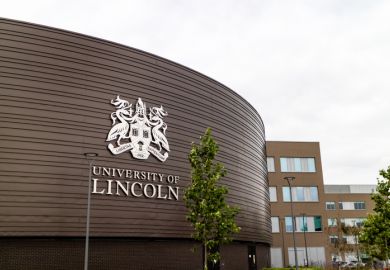Some faculty and students at St. Mary’s College of Maryland have a plan to get all of the college’s staff off welfare, ensure those lowest-paid employees see their wages rise with inflation and rein in administrative costs.
The plan would link presidential pay to that of the lowest-paid employees - in a way that would either force a cut in the salary at the top or raises for those at the bottom of the pay scale. It’s hard to imagine the idea is about to become adopted. But the debate, which is playing out in other forms elsewhere, raises questions about equity and values in higher education
The public liberal arts college’s Faculty Senate was set to consider a new salary plan last week. If the senate advances the plan, known as “St. Mary’s Wages, the St. Mary’s Way”, the full faculty will vote on whether to take the idea to the college’s board of trustees.
A spokeswoman for the college did not comment, but the administration has expressed skepticism about the proposal, which would limit the president’s salary to no more than 10 times the salary of the lowest-paid full-time staffer. That would be about $300,000 (£180,000), which is $26,000 less than the current interim president and could affect the college’s ongoing search for a new president.
“I think it’s something that would certainly provide a real incentive for the presidents of the university to care about how much money their lowest-paid employees are making,” said Jordan Price, an associate biology professor who helped draft the wage plan.
The focus on the growing disparity between executive compensation and the wages of the rank and file is nothing new, nor is St. Mary’s particularly inequitable. The president makes about 13 times as much as the lowest-paid staffer.
By comparison, in the corporate world, the CEO at clothing retailer Gap, which said last week that it would raise the minimum wage for its employees, made 331 times more than its average worker, according to a 2013 analysis by Bloomberg. But St. Mary’s plan isn’t as equitable as the compensation scale that ice cream maker Ben & Jerry’s once used, which didn’t allow executives to make any more than five times what an employee made.
The St. Mary’s proposal does more than just tie presidential pay to that of less well-compensated staff members. It also seeks to make sure all employees earn at least $29,976, which is 130 per cent of the poverty level and enough to keep a family of four off welfare such as food stamps.
The plan is just the latest in a decade-long fight over living wages for St. Mary’s employees.
About $18 million of the college’s $67 million operating budget comes from the state of Maryland. The living wage proposal would initially cost an additional $0,000. Backers think the money is available after the college cut $3.5 million from the budget to plug an enrolment shortfall. The shortfall, which cost a former president his job, ended up not being as bad as expected, and about $400,000 may now be free.
The bump in salary for staffers would mean some of the lowest-skilled laborers’ new wages would be at or above what others made, which might mean others would need to get raises. The plan could also force three highly paid professors and a vice-president to take a pay cut, though the plan allows for some exceptions.
There is also concern that the limits on presidential pay could turn away qualified candidates.
Sandy Ganzell, a mathematics professor and an author of the plan, said the next president of St. Mary’s should want to come because of the pay plan, not in spite of it. “I think part of my goal at least is to help attract someone to St. Mary’s College as our next president who understands the mission and believes in this mission,” he said.
The St. Mary’s plan is not the only of its kind.
After news of former Brandeis University president Jehuda Reinharz’s generous retirement package became public, an alumnus started a petition calling on the university to, among other things, prevent the highest-paid employee from making more than 15 times the salary of the lowest-paid employee.
Brandeis last month adopted new compensation disclosure rules, but failed to adopt such a formal limit on its pay. Current Brandeis president Frederick Lawrence received $540,000 in salary last year. That’s about 14 times more than the lowest-paid union janitor, who, according to the university, makes $38,355.
At the University of Miami, site of an epic battle over staff wages, President Donna Shalala makes $913,000, which is about 37 times the salary of a 40-hour-a-week janitor who makes, according to the staff union, $11.59 an hour.
At Vanderbilt University, where there’s been an ongoing staff push for higher wages, President Nicholas Zeppos makes about $1 million a year in salary and bonuses. Some cafeteria workers, who don’t work during the summer, have complained they make only $16,500 a year – or 61 times less than Zeppos. Those low-paid workers have lobbied for full-time employment from the university.
“As a policy, Vanderbilt does not discuss specific compensation numbers; however, what I can tell you is compensation – both pay and benefits – for employees at Vanderbilt is competitive in the marketplace,” university spokeswoman Melanie Moran said in an email.
Ben Eagles, a 2011 Vanderbilt alum and organiser at OUR Vanderbilt, which advocates for a “living wage” for university employees, said he liked the St. Mary’s idea of pegging wages at the top to wages at the bottom.
“I think it’s a great idea, I think it’s something that would certainly provide a real incentive for the presidents of the university’s to care about how much money their lowest paid employees are making,” he said.
Register to continue
Why register?
- Registration is free and only takes a moment
- Once registered, you can read 3 articles a month
- Sign up for our newsletter
Subscribe
Or subscribe for unlimited access to:
- Unlimited access to news, views, insights & reviews
- Digital editions
- Digital access to THE’s university and college rankings analysis
Already registered or a current subscriber? Login




